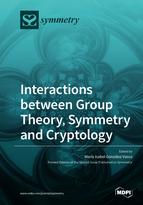Interactions between Group Theory, Symmetry and Cryptology
A special issue of Symmetry (ISSN 2073-8994). This special issue belongs to the section "Computer".
Deadline for manuscript submissions: closed (31 January 2020) | Viewed by 23913
Special Issue Editor
Interests: provable security; key establishment protocols; post-quantum cryptography; hard core functions
Special Issue Information
Dear Colleagues,
Cryptography lies at the heart of most technologies deployed today for secure communications. At the same time, mathematics lies at the heart of cryptography, as most cryptographic constructions set ground on algebraic scenarios ruled by group or number theoretical laws. Understanding the involved algebraic structures is, thus, essential to design robust cryptographic schemes.
This Special Issue is concerned with the interplay between group theory, symmetry and cryptography. Articles are solicited exploring the links and interactions between group theory, symmetry and cryptology. The topics of this Special Issue include, but are not limited to: The role of symmetry in analyzing the security of cryptographic schemes (such as multivariate post-quantum cryptosystems, hash functions, Boolean functions, etc.), cryptographic constructions using group theoretical tools, group theoretical results having an impact in cryptographic developments, etc.
Submissions that address only theoretical aspects are welcome; those that also address practical aspects are particularly encouraged.
Articles should be of one of the following types:
- Novel research contributions;
- Research contributions previously published or presented at conferences or workshops, but now substantially revised and containing substantial new contributions;
- Expository survey articles.
Prof. María Isabel González Vasco
Guest Editor
Manuscript Submission Information
Manuscripts should be submitted online at www.mdpi.com by registering and logging in to this website. Once you are registered, click here to go to the submission form. Manuscripts can be submitted until the deadline. All submissions that pass pre-check are peer-reviewed. Accepted papers will be published continuously in the journal (as soon as accepted) and will be listed together on the special issue website. Research articles, review articles as well as short communications are invited. For planned papers, a title and short abstract (about 100 words) can be sent to the Editorial Office for announcement on this website.
Submitted manuscripts should not have been published previously, nor be under consideration for publication elsewhere (except conference proceedings papers). All manuscripts are thoroughly refereed through a single-blind peer-review process. A guide for authors and other relevant information for submission of manuscripts is available on the Instructions for Authors page. Symmetry is an international peer-reviewed open access monthly journal published by MDPI.
Please visit the Instructions for Authors page before submitting a manuscript. The Article Processing Charge (APC) for publication in this open access journal is 2400 CHF (Swiss Francs). Submitted papers should be well formatted and use good English. Authors may use MDPI's English editing service prior to publication or during author revisions.
Keywords
- public key cryptogaphy
- secret key cryptogaphy
- symmetry
- group theory
- post-quantum cryptogaphy






